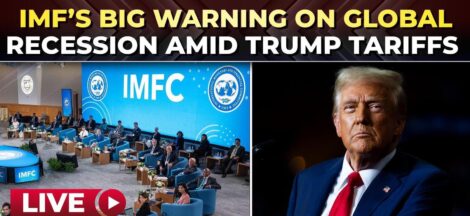The high level delegations of United States of America and China concluded their two day trade talks in London on Tuesday agreeing to take forward the course of negotiations for further promoting steady and healthy development of economic and trade ties between the two largest economies of the world. Both Chinese and U.S. sources underlined that the London talks were based on the guidelines set through phone conversations between President Trump and President Xi Jinping on June 5 as also the understanding arrived at the earlier meeting in Geneva last month.
In fact following the Geneva meeting last month, the Chinese side made lot of complaints that the U.S, agencies have been violating many of the principles agreed to at the Geneva meeting and this was hampering the proper implementation of the Geneva understanding. Chinese President’s office communicated this to the President Trump’s office and finally Trump spoke directly to President Xi Jinping on June 5 and discussed a few guidelines for trade discussions scheduled in London on June 9 and 10.
Now this London agreement based on that June 5 guidelines set by the two Presidents will be taken forward for further finetuning at the next meeting to be scheduled soon. U.S. sources say that the areas of discussions are so vast and the items are so many that a full fledged deal will take a few more rounds.US sources have hinted that the Trump administration is really keen in arriving at an early deal with China. So, the U.S. side will abide by the London agreement in the interests of normal trade relations between both the countries.
According to a latest survey released by the American Chamber of Commerce in China, although tariffs pose rising challenges to US companies in China, most companies are not planning to exit China, with none reporting shifting production back to the US. Chinese sources say that China is maintaining strategic patience in talks with the U.S. officials as there are some structural trade conflicts and these require time consuming discussions.
On Monday morning, China released the trade data for the first five months of 2025. China’s total goods imports and exports in yuan-denominated terms rose to 17.94 trillion yuan ($2.5 trillion) in the first five months of 2025, up 2.5 percent year-on-year, official data showed Monday.
The continuous growth in foreign trade underscores the resilience of the world’s second largest economy, with supply chain and industry chain remaining competitive in response to the world market demand, despite global headwinds highlighted by unilateralism, a Chinese expert said.
“Since the beginning of this year, China’s economy has continued to recover and improve. Under external pressure, the country’s goods trade has maintained strong resilience. By May, China’s imports and exports continued their growth trend, with the growth rate accelerating notably after the high-level China-US economic and trade talks,” said Lü Daliang, a GAC spokesperson, Xinhua reported on Monday
While China’s foreign trade generally saw a positive growth, uncertainties remain, as reflected in some trade figures. Media reported that last month, goods exports rose 6.3 percent year on year, while imports went down 2.1 percent. China-US trade decreased by 8.1 per cent year on year basis to1.72 trillion yuan during the first five months of 2025, according to Chinese customs data.
Li Changan, a professor at the Academy of China Open Economy Studies at the University of International Business and Economics, told the Global Times on Monday that data from May shows that while China’s foreign trade remained generally stable, some fluctuations did occur, likely linked to the trade tensions.
“China’s import and export growth accelerated significantly following recent high level trade talks between China and the US in Geneva. This suggests a rebound in foreign trade after the joint statement, partially offsetting the negative impact of the trade dispute and helping maintain overall trade stability,” Li said, adding that challenges persist as businesses expect more predictability in world trade.
The trend in China-US trade data was “expected,” as even though China and the US reached an agreement to significantly reduce reciprocal tariffs during the Geneva talks in May, US tariffs on Chinese goods remain high, prompting Chinese foreign trade companies to made adjustments by exploring alternative markets to reduce their reliance on the US, Huo Jianguo, a vice chairman of the China Society for World Trade Organization Studies in Beijing, told the Global Times on Monday.
The United States and China have a substantial trade relationship, with China being a major trading partner and a significant export market for the US. In 2024, total US-China trade in goods reached an estimated $582.4 billion, with US exports to China at $143.5 billion and imports from China at $438.9 billion, resulting in a trade deficit of $295.4 billion. China is the third-largest export market for the US, behind Canada and Mexico.
It is interesting that Chinese policy makers are making special efforts to woo the European Union in both political and trade areas by taking advantage of the current fissures in US-EU relations. The idea is to project China as a defender of multilateral trading as also WTO norms as against the unilateralism being followed by the US President Donald Trump.
However, there have been many setbacks to China-EU relations also. This month, the EU has taken steps to restrict Chinese medical devices from participating in its public procurement market, which was firmly opposed by the Chinese side. Recently, negative hype against China has increased in Europe. Following the “China spy” case and the so-called lobbying scandal related to Huawei, the Czech Republic openly accused China of launching a cyberattack against it, and the EU and NATO followed suit. Even after a major power outage in Europe, solar power inverters produced in China were questioned by some for “cybersecurity risks.”
In the recent days, China and Europe have conducted intensive diplomatic interactions. President Xi Jinping spoke with French President Emmanuel Macron and German Chancellor Friedrich Merz respectively, Vice Premiers He Lifeng and Liu Guozhong visited Europe successively, the Danish and Dutch foreign ministers visited China successively, and Foreign Minister Wang Yi spoke with the German and Polish foreign ministers. Vice Premier He Lifeng is currently in London on an official visit to the UK. He will be having intensive discussions on trade and political issues with the British Prime Minister Keir Starmer.
The European Parliament and China have decided to simultaneously and comprehensively lift restrictions on mutual exchanges, further sending a positive signal for expanding exchanges between the two sides. It’s reported that European Council President Antonio Costa and European Commission President Ursula von der Leyen will also visit China in July to hold meetings with Chinese leaders.
Chinese experts say that such setbacks are not unexpected taking into account the policies of EU members but still cooperation and collaboration are possible. China is interested in that. Over the past 50 years since establishing diplomatic relations, China and the EU have formed a strong economic symbiotic relationship, with annual trade increasing from $2.4 billion to $785.8 billion – a growth of over 300 times. Both sides have engaged in productive multilateral coordination and cooperation in areas such as climate change.
Both Chinese and EU sources say these collaborations have not only brought tangible benefits to nearly 2 billion people on both sides but have also made significant contributions to maintaining global stability and prosperity. In the current complex international situation, the China-EU relationship holds even greater strategic significance and global influence.
The Chinese perception is that the development of China-EU relations demonstrates that the two sides can fully respect each other, engage in equal dialogue, complement each other’s strengths, and achieve mutual success. The world is changing, but the fundamental fact that cooperation between China and the EU far outweighs competition, that consensus far exceeds differences, and that opportunities far exceed risks remains unchanged. (IPA Service)



 Maheshtala Temple Dispute Sparks Deadly Street Clashes
Maheshtala Temple Dispute Sparks Deadly Street Clashes 